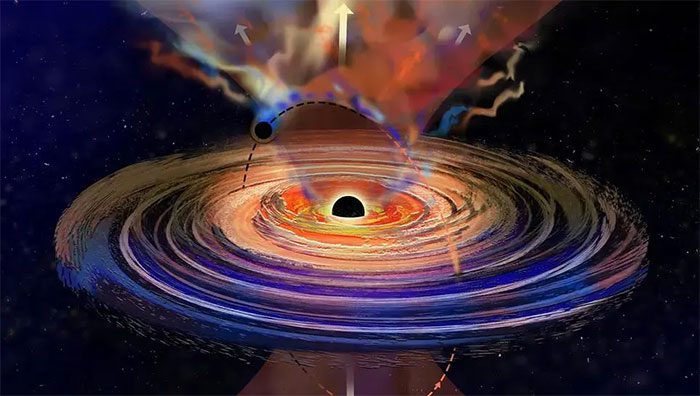A monstrous black hole has puzzled scientists as it “hiccups” once every eight and a half days.
According to Live Science, a team of scientists led by the Massachusetts Institute of Technology (MIT) and the Kavli Institute for Astrophysics and Space Research in the United States has discovered the first known “hiccuping” black hole.
This phenomenon suggests that the disk of material surrounding black holes may hold more mysteries than we previously thought.

“The Double Phantom” featuring a monstrous black hole and a smaller black hole that created the phenomenon puzzling scientists – (Graphic: MIT)
This strange monstrous black hole weighs approximately 50 million times that of the Sun and resides at the center of a galaxy 800 million light-years away from Earth, ejecting gas into space every eight and a half days.
This peculiar “hiccup” appears to originate from the black hole’s accretion disk, a swirling ring of superheated gas around the object, which is also what allows us to “see” the black hole, an entity that is fundamentally dark and invisible.
According to results published in the journal Science Advances, MIT scientists have finally identified the cause of this anomaly.
They did not just look at one black hole, but at two.
The smaller black hole is “roaming” around the larger one, occasionally passing through the accretion disk of the larger black hole and is the culprit behind this disturbance.
The lead author, Dheeraj Pasham, stated that the discovery of the second black hole was entirely unexpected.
“We had to scratch our heads for months until theorists from the Czech Republic came in and suggested a secondary black hole, which seemingly explains all the characteristics of this system,” Dr. Pasham noted.
Thanks to this, the authors were able to build models to examine this hypothesis and realized it was entirely plausible.
This discovery opens a new avenue for astronomers: Exploring the accretion disks of black holes, which may still conceal a world full of mysteries.


















































